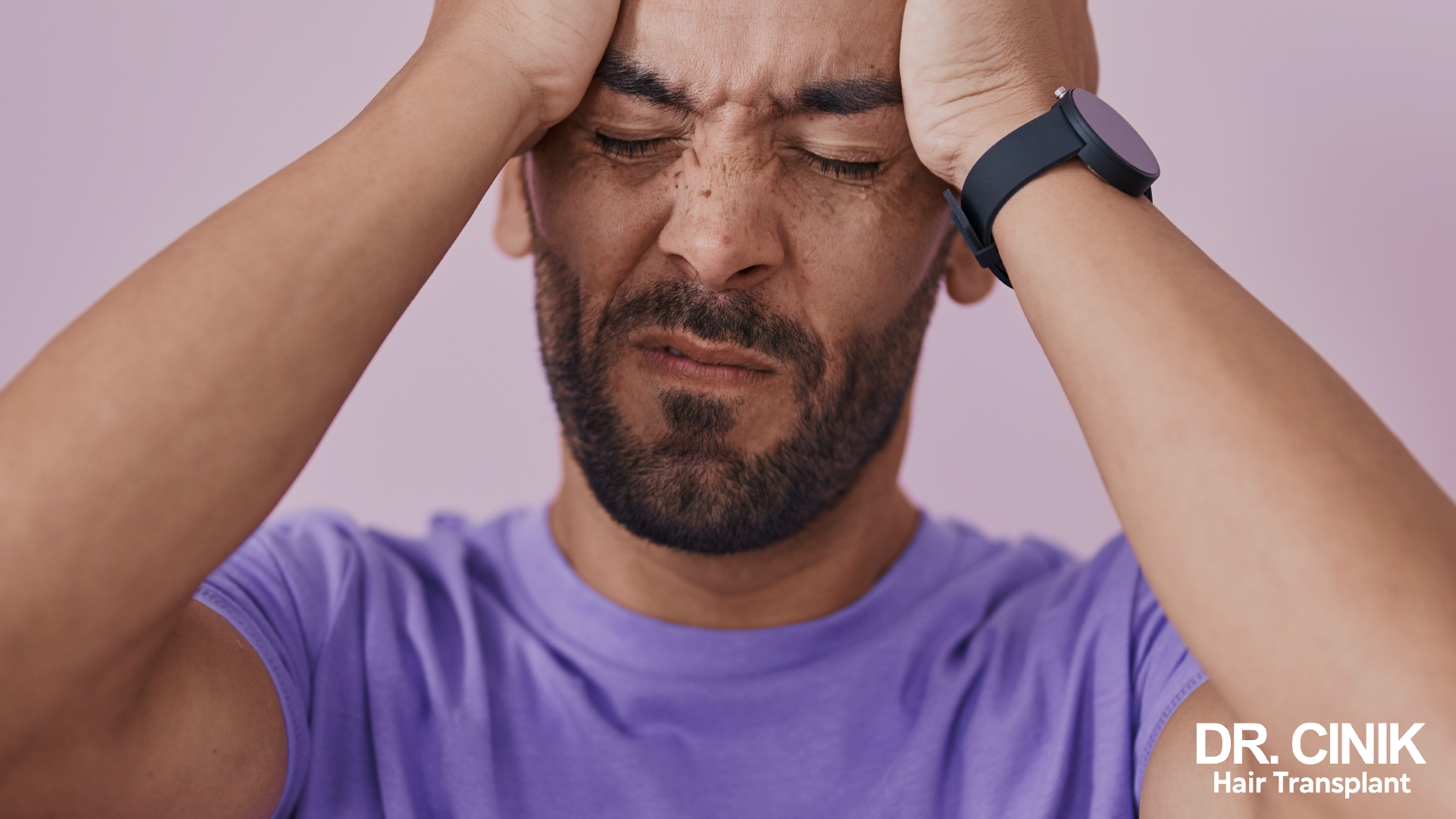Possible Side Effects and Complications After a Hair Transplant

Sommaire
Hair transplantation is currently the most sophisticated method for treating androgenetic alopecia. This procedure involves extracting hair follicles from a donor area at the back of the scalp and transplanting them into thinning areas. Although generally safe, like any surgical intervention, it may have several side effects. Fully understanding these risks is critical to preventing and managing them effectively.

Local Side Effects
Swelling and Redness
Moderate to severe swelling (oedema) is common around the donor and recipient sites within 2 to 10 days after a hair transplant. These inflammatory edemas are characterised by redness, warmth, and localised inflammation. They can spread to areas like the nose’s root, eyelids, or cheeks but typically diminish within a few days with symptomatic treatment, such as ice application, painkillers, and sometimes corticosteroids.
Sensations of Tension or Itching
Patients often experience a pulling sensation or uncomfortable tension at the donor scars and micro-incisions in the recipient area. These feelings usually subside within a few weeks. Itching can be alleviated with pain relief medication.
Numbness
Numbness or a loss of sensation is commonly reported around the operated areas following surgical trauma, especially with the linear incision in a FUT hair transplant. This numbness, indicating nerve damage, generally resolves over a few weeks.
Pain
Following a hair transplant, patients may experience pain of varying intensity, necessitating appropriate treatment. Short-term administration of painkillers of different strengths is often recommended. Typically, these inflammatory pains diminish over a period of 2 to 3 weeks.

Temporary Hair Loss: Shock Loss
A few weeks after the graft, temporary hair loss can occur in both the implanted and donor areas. Shock loss is a striking but benign and common side effect stemming from surgical shock.
Bruises
The development of bluish or purplish bruises (ecchymoses) around the areas where the grafts are harvested and implanted is a typical occurrence.
The Formation of Scabs
The emergence of brownish crusts on the surface of the micro-incisions is an inevitable part of the healing process. These scabs, essential for normal healing, usually take 1 to 3 weeks to disappear completely. It’s crucial not to remove them manually.

General Side Effects
In addition to the localised complications, hair transplant surgery can also lead to more widespread side effects that affect the body as a whole.
Intense Fatigue and Headaches
Substantial physical and psychological fatigue is almost always present in the days and weeks following hair transplant surgery. This marked asthenia has multiple causes: it is related to surgical trauma and the disruptive post-hair transplant sleep patterns caused by discomfort. Intense headaches, commonly associated with this fatigue, are particularly frequent during the first 48 hours.

Nausea and Vomiting
Nausea and vomiting are pretty common within the first 24-48 hours post-hair transplant surgery. These digestive issues stem from various factors: the use of local anaesthetics, opioid painkillers, irritation caused by bleeding, pain, etc. Antiemetic medications are often necessary to alleviate vomiting and oral or intravenous rehydration, depending on the situation.
Rare Side Effects of FUT Hair Transplants
Hypertrophic Scars
In a minority of patients, the suture lines from a FUT hair transplant may evolve into thick, raised scars, known as hypertrophic scars. These are challenging to prevent and may necessitate local corticosteroid injections to decrease their size and alleviate associated itching.

Extremely Rare Complications
Fortunately, severe or life-threatening complications after a hair transplant are exceedingly rare. However, a few isolated cases have been documented in medical literature.
Anaphylactic Shock
Exceptionally, severe allergic reactions can occur during or immediately after the hair transplant, typically related to the injection of local anaesthetics. These hypersensitivity reactions can lead to giant urticaria, angioedema, or even anaphylactic shock, which can be life-threatening. Emergency medical intervention is crucial (adrenaline, intravenous fluids, oxygen, etc.).
Compressive Hematomas
The formation of extensive deep hematomas around the donor area or in the subcutaneous tissues of the face is extremely rare but can be gravely serious. These massive hematomas can cause significant deformity and potentially compress the airways, requiring emergency evacuation or even a fresh blood transfusion.
Necrotizing Infections
Rare skin infections following hair transplants have been reported despite strict hygiene measures. In most of these cases, the bacteria involved are resistant to standard antibiotics.

Psychological Complications
Beyond medical and surgical complications, hair transplants can also lead to psychological repercussions if patients are dissatisfied with the aesthetic outcome.
Patient Dissatisfaction
An outcome perceived as unsatisfactory by the patient can be deeply distressing, whether due to insufficient hair density, an unnatural or improperly positioned hairline, abnormal hair angulation, or asymmetry in the treated area. Psychological or even psychiatric support should be offered, particularly for patients who are emotionally fragile or have dysmorphophobia. Sometimes, a secondary procedure might be considered to enhance the aesthetic result.
Depressive Disorders
In rarer instances, hair transplant procedures that are challenging in terms of functionality and pain management can lead to serious depressive disorders. A treatment approach that combines psychological support with short-term antidepressants may be necessary to address this postoperative depression. It’s important to recognise that both medical complications and aesthetic disappointment after a hair transplant can have a profound psychological impact.
 en
en



